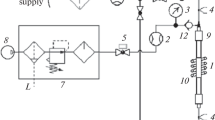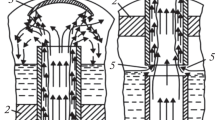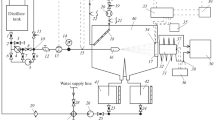The authors have presented results of experimental investigation into the possibility of using dispersed two-component flows of the coolant to remove heat from the structural elements of thermonuclear facilities and reactors with a high energy density. Based on the array of experimental data, a criterial equation has been obtained for the heat transfer from the high-temperature surface to the dispersed two-component coolant. The existence of two heat-transfer regimes depending on the temperature of the cooled structural element has been established and the promising nature of this method of recuperation of the energy of structures interacting with high-temperature plasma has been confirmed.
Similar content being viewed by others
References
I. Lyublinski, A. Vertkov, S. Mirnov, and V. Lazarev, Protection of tokamak plasma facing components by a capillary porous system with lithium, J. Nucl. Mater., 463, 1156–1159 (2015)
S. V. Mirnov, A. M. Belov, N. T. Djigailo, et al., Recent lithium experiments in tokamak T-11M, J. Nucl. Mater., 438, 224–228 (2013).
S. V. Mirnov, A. M. Belov, and N. T. Djigailo, et al., Experimental test of the system of vertical and longitudinal lithium limiters on T-11M tokamak as a prototype of plasma facing components of a steady-state fusion neutron source, Nucl. Fusion, 55, Article 123015 (2015).
A. V. Dedov, A. Varava, A. T. Komov, and V. V. Yagov, Hydrodynamics and heat transfer in swirl flow under conditions of one-side heating. Part 1: Pressure drop and single-phase heat transfer, Int. J. Heat Mass Transf., 53, Issues 19–20, 4123–4131 (2010).
A. V. Dedov, A. Varava, A. T. Komov, and V. V. Yagov, Hydrodynamics and heat transfer in swirl flow under conditions of one-side heating. Part 2: Boiling heat transfer. Critical heat fluxes, Int. J. Heat Mass Transf., 53, Issues 21–22, 4966–4975 (2010).
F. F. Tsvetkov and B. A. Grigor’ev, Heat and Mass Transfer: A Textbook for Universities [in Russian], Izd. MÉI, Moscow (2001).
Author information
Authors and Affiliations
Corresponding author
Additional information
Translated from Inzhenerno-Fizicheskii Zhurnal, Vol. 94, No. 6, pp. 1471–1476, November–December, 2021.
Rights and permissions
About this article
Cite this article
Mirnov, S.V., Varava, A.N., Vertkov, A.V. et al. Distinctive Features of Heat Transfer During the Cooling of the Working Section by a Dispersed Flow. J Eng Phys Thermophy 94, 1438–1443 (2021). https://doi.org/10.1007/s10891-021-02424-4
Received:
Published:
Issue Date:
DOI: https://doi.org/10.1007/s10891-021-02424-4




